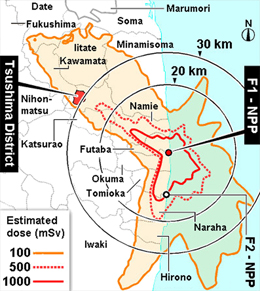Research Abstract
福島原子力発電所事故による避難者の甲状腺線量
Thyroid doses for evacuees from the Fukushima nuclear accident
2012年7月12日 Scientific Reports 2 : 507 doi: 10.1038/srep00507

東京電力福島第一原子力発電所事故直後の被災地の居住者と避難者の主な健康上の懸念は、放射性ヨウ素、特にヨウ素-131による甲状腺の内部被ばくにともなう甲状腺がんのリスクである。2011年3月に日本で起きた地震と津波の自然災害によって、福島第一原子力発電所(F1-NPP)は重要な機能を失い、大量の放射性物質が環境中に放出された。今回われわれは、高汚染地域での居住者と沿岸域からの避難者の62名に対してヨウ素-131の被ばく線量を初めて測定した結果を報告した。測定した62人のうち46人から甲状腺におけるヨウ素-131が検出された。甲状腺等価線量の中央値は、未成年者で4.2 mSv、成人で3.5 mSvと見積もられた。この値は、チェルノブイリ事故の避難者の甲状腺線量の平均値(490 mSv)よりはるかに小さい。甲状腺線量の最大値は、未成年者で23 mSv、成人で33 mSvであった。
床次 眞司1, 細田 正洋2, 秋葉 澄伯3, 反町 篤行1, 柏倉 幾郎1,2 & Mikhail Balonov4
- 弘前大学被ばく医療総合研究所 放射線物理学分野
- 弘前大学大学院 保健学研究科 医療生命科学領域 放射線生命科学分野
- 鹿児島大学大学院 医歯学総合研究科 健康科学専攻 人間環境学講座
- Protection Laboratory, Institute of Radiation Hygiene(ロシア)
A primary health concern among residents and evacuees in affected areas immediately after a nuclear accident is the internal exposure of the thyroid to radioiodine, particularly I-131, and subsequent thyroid cancer risk. In Japan, the natural disasters of the earthquake and tsunami in March 2011 destroyed an important function of the Fukushima Daiichi Nuclear Power Plant (F1-NPP) and a large amount of radioactive material was released to the environment. Here we report for the first time extensive measurements of the exposure to I-131 revealing I-131 activity in the thyroid of 46 out of the 62 residents and evacuees measured. The median thyroid equivalent dose was estimated to be 4.2 mSv and 3.5 mSv for children and adults, respectively, much smaller than the mean thyroid dose in the Chernobyl accident (490 mSv in evacuees). Maximum thyroid doses for children and adults were 23 mSv and 33 mSv, respectively.

